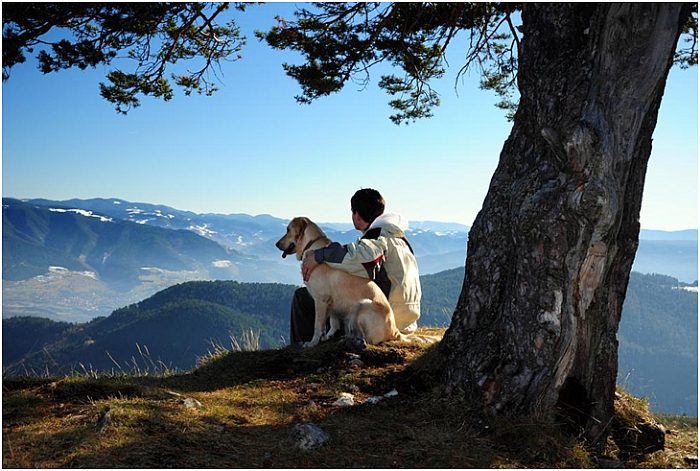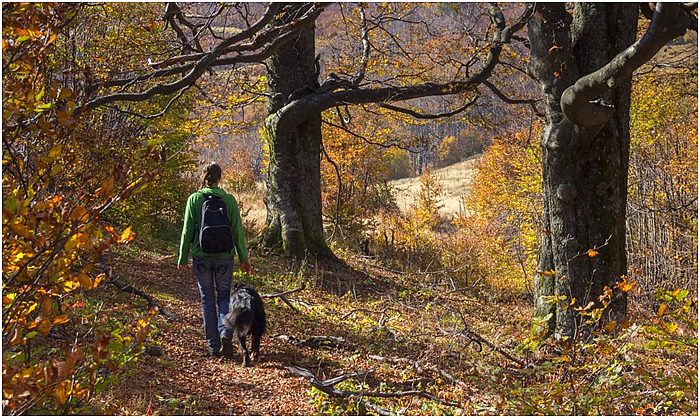Hiking is one of the most invigorating activities, but it’s even better when you can share it with your furry friend.

It is an excellent form of aerobic exercise that improves cardio-respiratory fitness, especially for your heart, blood vessels, and lungs. This type of exercise helps to prevent cancers, diabetes, and heart disease. Hiking also keeps the extra pounds off, and it promotes better sleep and mental health.
But aside from the health benefits, hiking with your dog is also beneficial for your well-being. You and your dog need variety and stimulation, both of which hiking can provide. It also allows both of you to immerse yourselves in the natural world, regenerate your mental health, and reduce your stress level.
Best of all, it’s an incredible opportunity to bond with your pet.
But before you begin, there are a few considerations and preparations to be done before you can go out into the great outdoors together:
1. Consult with your vet
First things first, you should pay a visit to your vet and make sure your dog is fit and ready to be your hiking buddy.
Questions to ask
Is your dog physically ready?
Your dog’s bones need to be fully developed before taking her out on long hikes. In most cases, a dog reaches adulthood when she’s 1 year old, but for some larger breeds, this could be up to 2 years old.
Your vet will also be able to tell if you if she is physically able to go on long trails, taking into account age and other health conditions.
Does your dog need any vaccinations?
Depending on the area you are hiking in, there may be vaccinations or preventative medicines your dog will need. It’s good to find this out to keep your dog as safe as possible.
2. Brush up on obedience training
Before heading out together, you should brush up on obedience training. Make sure your dog has good recall, as you will need to keep control of her at all times.
You should also expose her to cyclists, horses, dogs, and other walkers before heading out on a hike. By getting her used this, she won’t be surprised and either run scared or show aggressive behavior when out on a trail.
By keeping her calm and in control, you will be able to respect the trail etiquette.
3. Find an appropriate trail

It’s best to choose trails with wooded areas that provide lots of shade to avoid getting overheated. The terrain should be soft, without too many sharp rocks, as these could hurt her paws.
Avoid hiking near any sheer drops, particularly on trails where she can be off leash (though this is uncommon).
If you find your dog is showing anxious behavior around horses or bikes despite your best efforts, then choose areas that aren’t so frequented by riders and bikers.
Also, an important consideration is: how long is the trail? Make sure you take into account how active your dog is. While Boxers and German Shepherds might be able to go for hours (with rest stops and water), less active dogs like Shih Tzus will likely get tired sooner.
4. Prepare your dog’s pack
If your dog is going to wear a pack, make sure it’s well-fitted, but not so tight that it will be uncomfortable. There should be enough space for you to fit two fingers under it.
The total weight of the pack should be no more than one-third of your dog’s body weight, and it should be weighted on both sides equally. In this pack you can put all the gear she will need, including her food, water, bowls, as well as any other extras you need for yourself.
5. Prepare essential items

Food
Your dog will need more dog food than she normally has, as she will be burning off more energy than usual. The general rule is to start with her usual amount and add one cup for every 20 pounds of dog weight.
Water
Use your own thirst as a guide for when to give your dog water. Usually every 30 minutes is fine, but if it’s hot or the trail is particularly difficult, she will need to drink about every 15 minutes.
Make sure you take a container for her to drink from and enough water to last you both the whole hike.
First Aid Kit
It’s a good idea to take a doggie first aid kit out on the trail with you, since there won’t be a vet nearby in case of emergency.
Organizations such as the Red Cross sell first-aid kits, and you can also find checklists so that you’re well-prepared before you set off. In this kit, you can put any other medicines your vet has given you.
Leash
Most trails require dogs to be on a leash, which must be 10 feet or shorter. So, you should use a short heeling leash or a moderate length one that can be quickly shortened for your dog to come to heel.
Coat and booties
If your dog has a thin coat, or if the temperature is low, taking a quality dog coat is a good idea.
Also, it’s important to take care of your dog’s footpads, as, if they’re not used to hiking, they can become sore. Having some booties will help protect your dog’s feet on rougher ground. You should put them on at home first to get her used to them.
If left on too long, especially in hot temperatures, a dog can overheat, so make sure you use these only when necessary.
6. Be aware of hazards
It’s important to be aware of the following dangers to keep your furry friend safe:

Overexertion and overheating
When you stop for a break, monitor how fast your dog’s breathing and heart rate normalize. If she is still struggling to recover after 5 minutes, start to take more frequent breaks, or make your hike shorter.
Dogs can also suffer from heatstroke. So, in temperatures over 20 degrees, make sure you rest frequently and provide your dog with lots of water to keep her hydrated.
Plants
The best way to prevent your pooch from eating any poisonous plants or from getting digestive upset is to monitor her at all times. If you catch her chewing on a plant, stop her immediately.
Dogs can also get bothersome plants stuck in their fur, but the ones you need to really watch out for are “foxtails,” as these can cause serious harm to your dog if they work their way into their vital organs. So, try to avoid areas with grasses that contain foxtails, which are more prolific in spring and summer.
Water safety
Dogs are at risk of getting ill from waterborne pathogens just as much as humans, so discourage her from drinking (or jumping into!) water along the trail. Give her fresh water carried by you or herself in her doggie pack.
7. Always clear up
Last but not least, stick to the “leave no trace” principle and always clear up your dog’s mess. Bag it and dispose of it when possible, or bury it in a hole at least 6 to 8” deep. It’s important that the hole is at least 200 feet from water sources, trails, and campsites.
Conclusion
We hope this guide has given you a good starting point to prepare yourself and your pooch for safe and enjoyable hikes together.
As long as you’re well-prepared and aware of any potential dangers, you’ll have a fantastic experience sharing the great outdoors with your four legged hiking partner.



I have a dog, but I have never taken him hiking with me. This is a great guide.
I didn’t try hiking with my dog.
I never tried hiking with dog before. But I am planning for doing this soon. Thank you so much for your valuable tips. It will help me a lot.